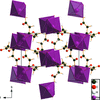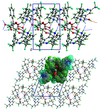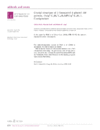issue contents
June 2016 issue

Cover illustration: Although solving crystal structures from powder diffraction data has become a routine method, examples of published structures are still outnumbered by those based on single-crystal data. A second modification of sodium dihydrogen citrate, Na+·H2C6H5O7-, was solved and refined from laboratory X-ray powder data from a commercial sample. Whereas in the known polymorph octahedral [NaO6] groups form edge-sharing pairs bridged by two hydroxy groups, in the new polymorph, [NaO7] polyhedra are fused by edge-sharing into chains. Another difference is that the central carboxylate group is deprotonated in the known polymorph while one of the terminal carboxyl groups is deprotonated in the new polymorph. The experimentally determinded structure of the new polymorph was optimized using density functional techniques. See: Rammohan & Kaduk [Acta Cryst. (2016). E72, 854-857].
research communications




















































 journal menu
journal menu













































